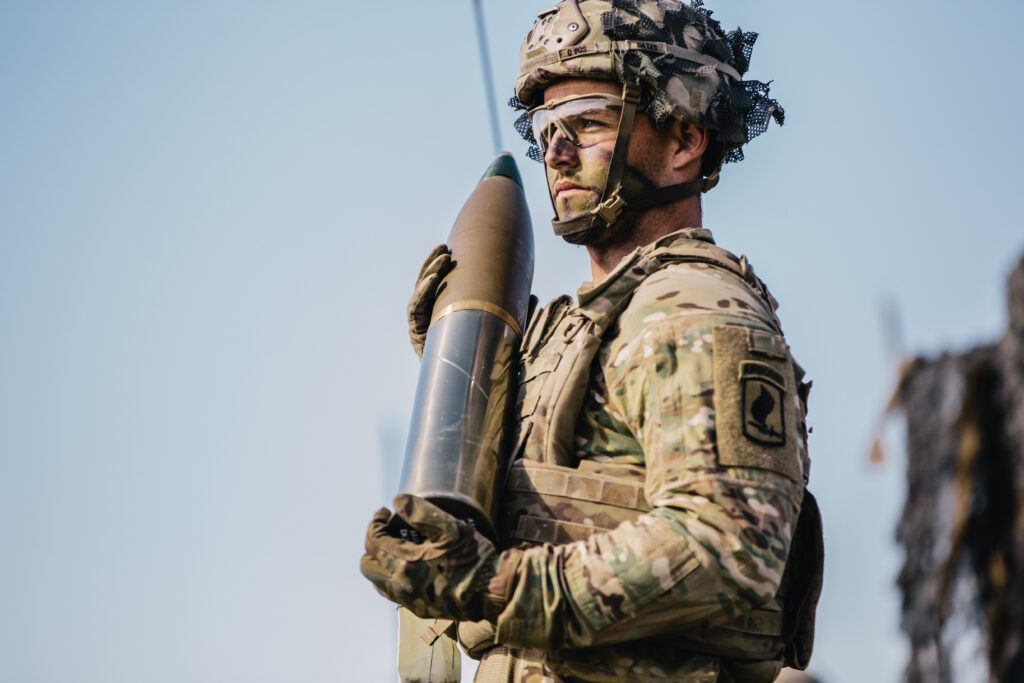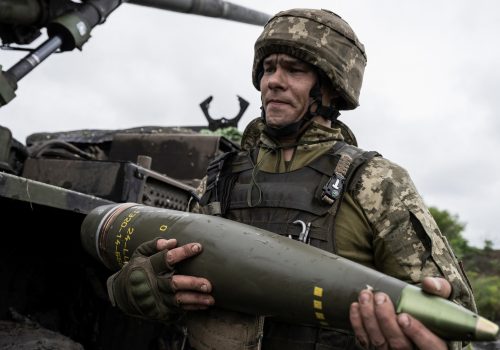In recent decades, US foreign policy has been beset by visions of the United States ensuring security throughout much of the world, but with little thought to the resources or resolve required or the second-order consequences. One would do well to remember the words of British writer Aldous Huxley: “good ends . . . can be achieved only by the employment of appropriate means.” This notion is specifically relevant when reflecting on the US defense ecosystem—one bearing an industrial base that had struggled to meet capacity long before conflict erupted in Ukraine and Israel in recent years. While maintaining regional stability across the globe is critical to US defense and national security objectives, simultaneously supplying major arms packages to Israel and Ukraine, at a time when the United States needs to prepare for the possibility of armed conflict with China, will stretch production lines and resources beyond sustainable limits, potentially jeopardizing all US-supported efforts.
Recently, the US response to conflict in the Middle East and to Russia’s war in Ukraine has brought to light growing concerns about US defense industrial capacity and about the spectrum of security cooperation the United States deploys. Limited resources within the Department of Defense are polarizing debates in Washington and beyond about which country needs help more: Israel or Ukraine? The real answer is less simple than one or the other. While maintaining Israel’s and Ukraine’s sovereignty are both critical to US national security objectives, the size of the United States’ involvement in helping each could, in turn, gamble with many of the same security objectives.
The hollowing out of the broader US manufacturing base has made defense companies dependent on supply chains originating in, of all places, China.
The capabilities needed in Ukraine, Israel, and a potential conflict with China vary, which prompts many US commentators to argue that the United States can sustain all three. However, that presumption undermines alarms raised across the federal government. Both the administration and the Department of Defense have highlighted their concerns about vulnerabilities resulting from a dependence on a shrinking number of sub-tier providers and the disruption on US defense supply chains caused by geopolitical instability.
US defense industries are wheezing in fundamental categories of weapons production. Several decades of inadequate defense budgets compounded with poor management of major Department of Defense acquisition programs has left the nation with a force whose inventory of vital weapons is smaller, older, and less ready for combat. The hollowing out of the broader US manufacturing base has made defense companies dependent on supply chains originating in, of all places, China. From electronic components to gallium, Chinese companies export unconscionable percentages of indispensable subcomponents and materials on which US production lines depend.
To put this into perspective, US stocks of precision-guided munitions are perilously low. If the United States were to engage in a Pacific conflict, the US military would run out of these munitions within three to ten days. Meanwhile, Israel is in an existential fight, running through its inadequate weapons reserves as Ukraine commands $44.2 billion to date in US military assistance just to stay afloat. Frankly put, the US defense industrial base is a fraction of what it was when the United States codified commitments to Israel. Despite the immense strain on domestic manufacturing capacity, Washington continues to put greater investment in mounting commitments abroad than in the health of the US industrial base. There are no plans in place for a major expansion nor the significant budget increases required.
Make no mistake, this does not call for the abandonment of Ukraine or Israel. Ukraine is a critical regional strategic partner whose territorial integrity is key to both US and international security. Further, allowing Ukraine to fight Russia is arguably a more favorable alternative than forcing NATO to do so. On a similar token, US support to Israel emerged not in a flash, but from decades of step-by-step US-Israel alliance building and consideration of the dilemma created by the United States selling weapons to Arab states. Israel has been the cornerstone of US strategy in the Middle East since the Cold War, and as the leading Western influence in the region, the United States relies heavily on Israel’s sustained and protected existence. Regardless, careful mind must be paid to the true cost of US security commitments and their impact on longstanding partnerships and alliances.
Moving into an election year in the United States, a rise in exports of US military assistance while the domestic defense ecosystem withers could reignite skepticism and scrutiny among key US decision makers toward NATO. Reverting back to the previous administration’s disdain for multilateralism risks bringing down the entire security edifice that US statesmen erected in Europe, Asia, and the Middle East during the twentieth century.
Prioritizing US strength helps US allies and partners
While US leadership is critical, mounting world crises require a division of labor among allies. The United States carries the overwhelming load, and the US warfighter is dangerously stretched—so much so that the military’s standards for new recruits dropped significantly last year in a desperate attempt to fill ranks. Retainment is at an all-time low. China and Iran know it; hence, their galling military provocations from Taiwan to the Red Sea. US armed forces may be the strongest in the world, yet they are too small to handle the country’s many commitments abroad. As European allies continue to step up their support to Ukraine, the United States should take this pivotal opportunity to reinvest and rebuild US manufacturing prowess.
The United States prioritizing its own strength is the only sustainable path to support Ukraine and uphold every other commitment made by the country to allies and partners. US leaders and policymakers should be unwavering in their commitment to Ukraine’s sovereignty. But in order to provide security assistance responsibly, they must first ensure a robust and well-resourced US defense industrial base, guaranteeing the United States’ long-term ability to support allies and partners while deterring adversaries.
NATO allies collectively enjoy an economy in excess of forty trillion dollars, top-tier military technologies, and a surplus of F-16 fighter jets, which, if provided in number, could make a large difference in Ukraine’s objective of recapturing its territory. Europeans not only have the fighter-bombers, but also the complex logistical and training networks to get Ukrainian pilots in the air quickly and create conditions for breaking the current stalemate. Decisions like these, however, require alignment on both sides of the pond. The US administration only recently provided the green light for Europe to provide Ukraine’s pilots with F-16 aircraft and training, which Air Force Secretary Frank Kendall deemed a key capability for Ukraine’s long-term defense.
Pursuing regional stability in Europe and the Middle East simultaneously are critical and costly endeavors. Doing so at the current pace in light of capacity limitations could backfire and damage not only Ukraine but also NATO. At the same time, the United States lacks the requisite focus to take on a Chinese threat to Taiwan and to defend its Pacific position because the US military and defense industrial base are stretched thin. This problem must be addressed now—a time when the United States’ European allies’ continued support for Ukraine affords the opportunity to do so.
In short, the United States faces a strategic choice. Its means are insufficient to achieve its ends. To close the gap, it must move one or the other.
Bringing the ends closer to the current means can be done in part by reassessing US commitments abroad. US policymakers should conduct a thorough review of current US security commitments, evaluating their strategic importance and resource demands, and scaling back involvement in certain regions to prioritize critical threats where necessary. It will be difficult work, which will include building a widely shared US political consensus on prioritizing among the considerable dangers existing in disparate parts of the world.
Bringing the means closer to the current ends also presents a challenge, namely the US Congress appropriating more funding. And to keep this funding “appropriate” in the eyes of Americans, US political leaders need to foster great unity on the United States’ international role and strategic priorities. Transparency and enhanced visibility on the current limitations of US industrial capacity and the cost of maintaining the current security architecture is vital to sustain Western leadership.
As the White House and Congress begin work on a budget for 2025, a first step they could take is to prioritize a domestic resurgence of the US industrial base. The United States needs an additional three hundred billion dollars in the annual defense budget directed toward revitalizing the US defense industrial base, by expanding capacity and diversifying supply chains to eliminate dependence on volatile foreign sources. This requires a significant budget increase and commitment to long-term rebuilding.
Kathryn Levantovscaia is deputy director of the Forward Defense program in the Atlantic Council’s Scowcroft Center for Strategy and Security.
Further reading
Wed, Dec 20, 2023
Expanding NATO’s competitive mindset: Deterring and defending across physical and virtual domains
Strategic Insights Memo By Delharty Manson
In October 2023, the Scowcroft Center for Strategy and Security’s Forward Defense program, in partnership with NATO ACT, convened current and former practitioners for a private workshop on expanding NATO’s approach to multi-domain operations (MDO), identifying key challenges and opportunities to operationalizing MDO across the Alliance. This memo summarizes the workshop’s key takeaways and conclusions.
Wed, Apr 12, 2023
Atlantic Council Commission on Defense Innovation Adoption interim report
Report By
The DoD must accelerate defense innovation adoption from the leading edge of the private sector. This report has ten recommendations to do so.
Fri, Sep 29, 2023
Jets and rockets are important, but Ukraine also needs faster munitions deliveries
New Atlanticist By Thomas S. Warrick
Today’s battlefield chews up ammunition and equipment at extraordinary rates. The US “arsenal of democracy” needs to start working overtime.
Image: A US Army paratrooper assigned to 4th Battalion, 319th Field Artillery Regiment, 173rd Airborne Brigade holds a round prior to loading it into a field artillery weapon in Grafenwoehr Training Area, Germany, July 29, 2020 in preparation for Exercise Saber Junction 20, taking place next month. (US Army photo by Spc. Ryan Lucas)



